Identifying and Analyzing Logical Fallacies in Editorial Articles
VerifiedAdded on 2023/06/13
|8
|1722
|137
Homework Assignment
AI Summary
This assignment analyzes an editorial titled "Screens In Schools Are a $60 Billion Hoax" by Dr. Nicholas Kardaras, published in Time, Inc. Of The New York Times. The student identifies and explains the logical fallacies present in the article, specifically the Strawman and False Cause fallacies. The assignment provides examples of how these fallacies are used to sway the reader, discussing the misrepresentation of arguments and the confusion of correlation with causation. The student also evaluates the arguments presented, suggests additional evidence to support the points, and reflects on how the assignment can aid future coursework. The analysis demonstrates a critical understanding of logical fallacies and their impact on persuasive writing.
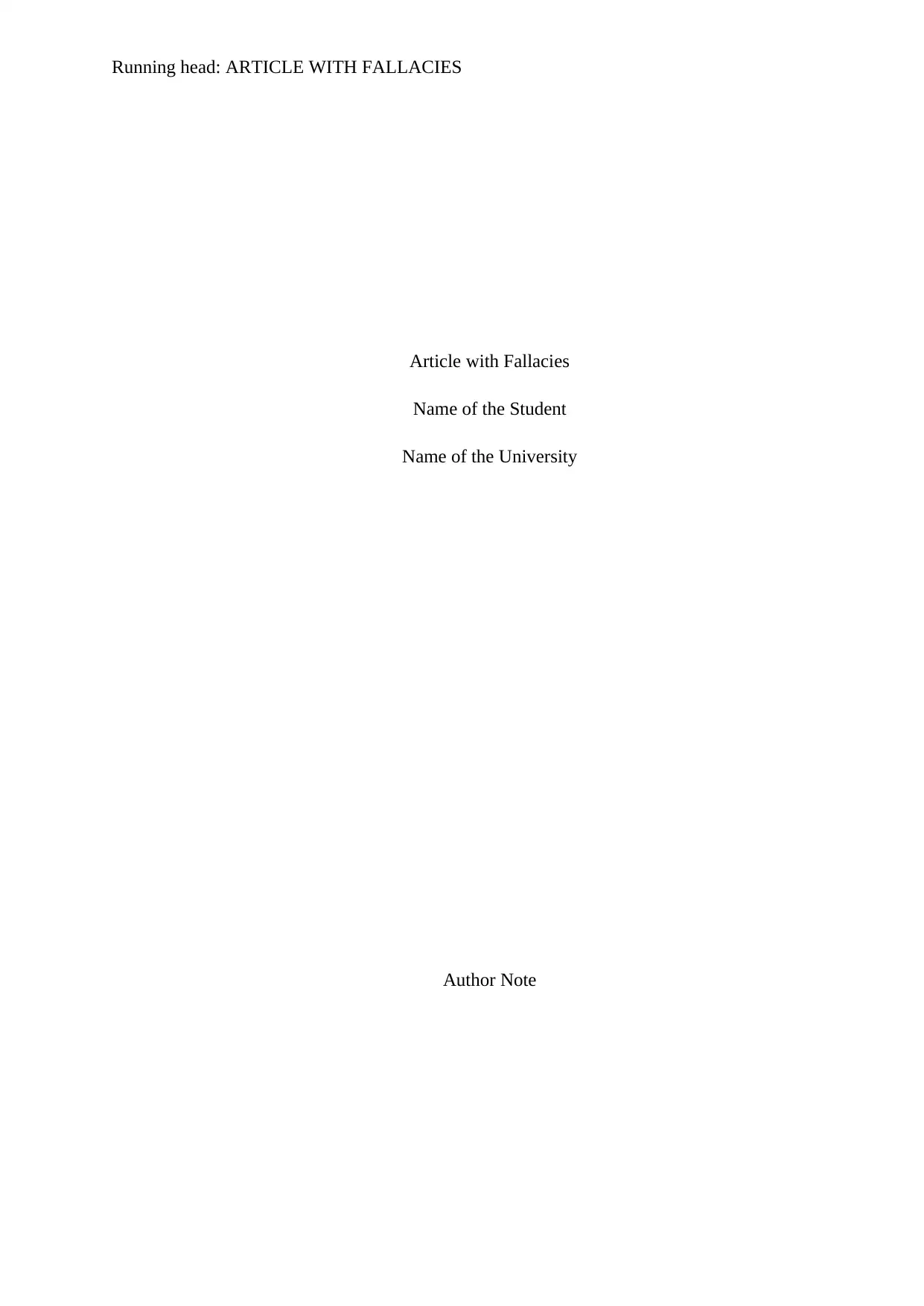
Running head: ARTICLE WITH FALLACIES
Article with Fallacies
Name of the Student
Name of the University
Author Note
Article with Fallacies
Name of the Student
Name of the University
Author Note
Paraphrase This Document
Need a fresh take? Get an instant paraphrase of this document with our AI Paraphraser
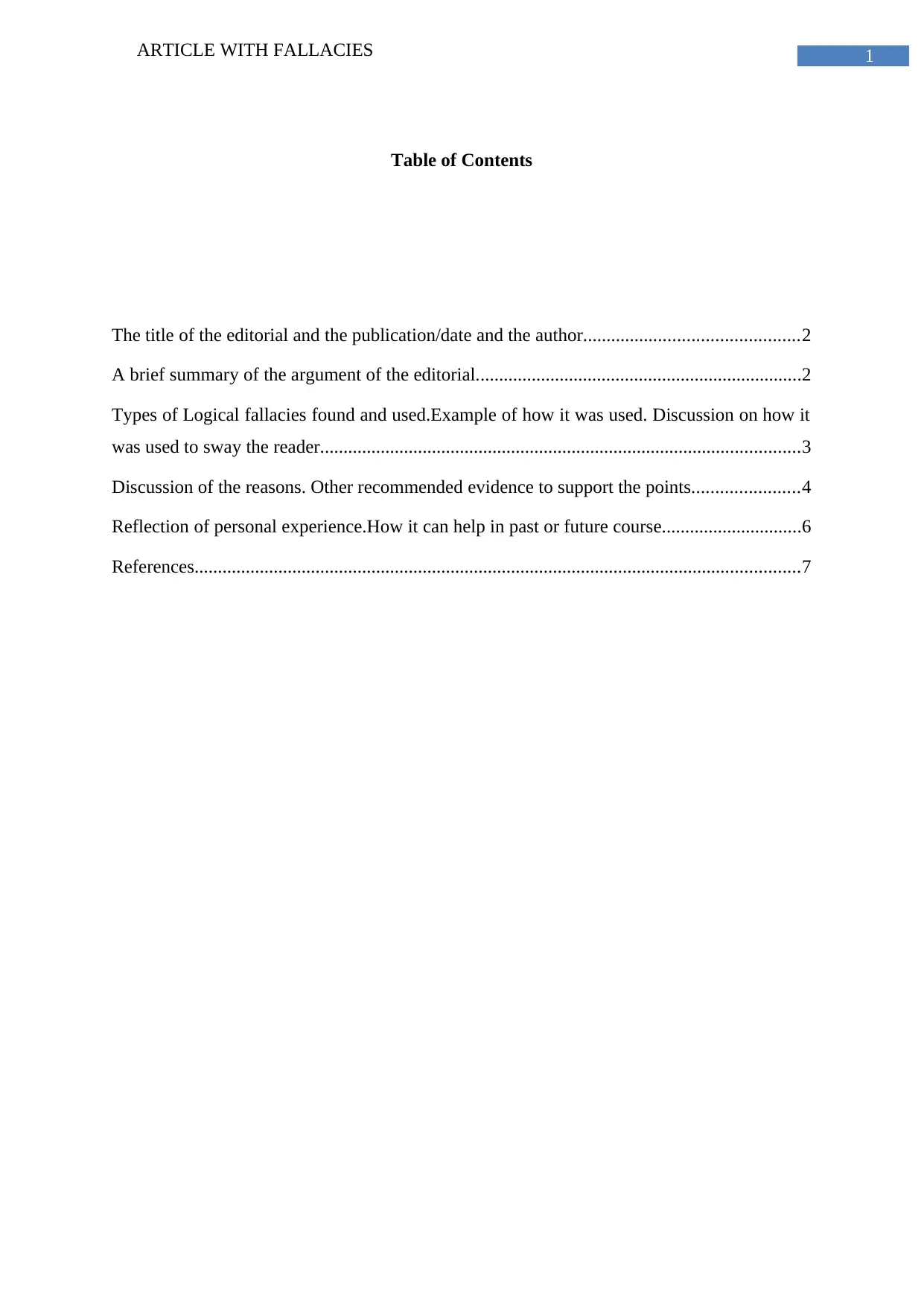
1ARTICLE WITH FALLACIES
Table of Contents
The title of the editorial and the publication/date and the author..............................................2
A brief summary of the argument of the editorial......................................................................2
Types of Logical fallacies found and used.Example of how it was used. Discussion on how it
was used to sway the reader.......................................................................................................3
Discussion of the reasons. Other recommended evidence to support the points.......................4
Reflection of personal experience.How it can help in past or future course..............................6
References..................................................................................................................................7
Table of Contents
The title of the editorial and the publication/date and the author..............................................2
A brief summary of the argument of the editorial......................................................................2
Types of Logical fallacies found and used.Example of how it was used. Discussion on how it
was used to sway the reader.......................................................................................................3
Discussion of the reasons. Other recommended evidence to support the points.......................4
Reflection of personal experience.How it can help in past or future course..............................6
References..................................................................................................................................7
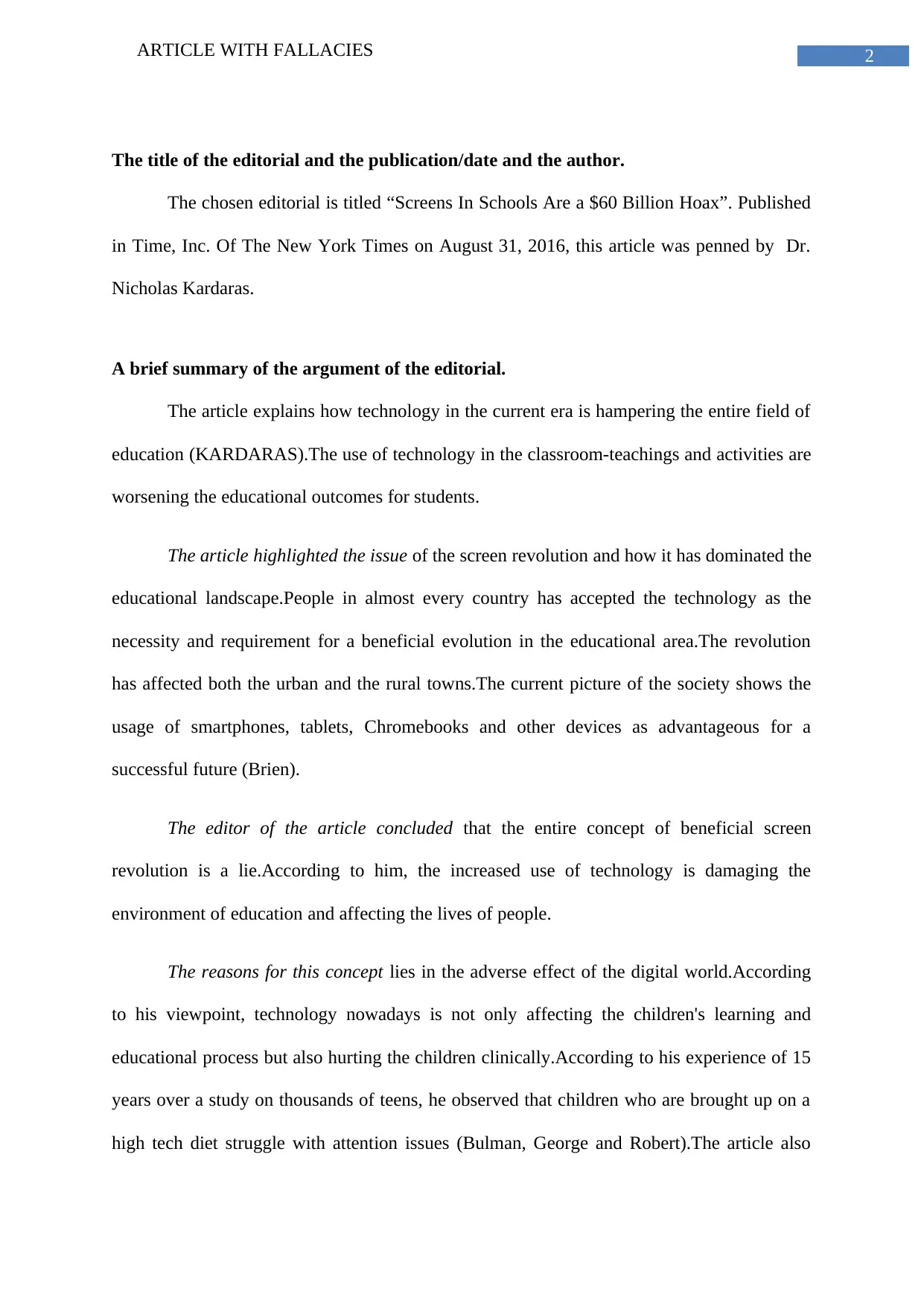
2ARTICLE WITH FALLACIES
The title of the editorial and the publication/date and the author.
The chosen editorial is titled “Screens In Schools Are a $60 Billion Hoax”. Published
in Time, Inc. Of The New York Times on August 31, 2016, this article was penned by Dr.
Nicholas Kardaras.
A brief summary of the argument of the editorial.
The article explains how technology in the current era is hampering the entire field of
education (KARDARAS).The use of technology in the classroom-teachings and activities are
worsening the educational outcomes for students.
The article highlighted the issue of the screen revolution and how it has dominated the
educational landscape.People in almost every country has accepted the technology as the
necessity and requirement for a beneficial evolution in the educational area.The revolution
has affected both the urban and the rural towns.The current picture of the society shows the
usage of smartphones, tablets, Chromebooks and other devices as advantageous for a
successful future (Brien).
The editor of the article concluded that the entire concept of beneficial screen
revolution is a lie.According to him, the increased use of technology is damaging the
environment of education and affecting the lives of people.
The reasons for this concept lies in the adverse effect of the digital world.According
to his viewpoint, technology nowadays is not only affecting the children's learning and
educational process but also hurting the children clinically.According to his experience of 15
years over a study on thousands of teens, he observed that children who are brought up on a
high tech diet struggle with attention issues (Bulman, George and Robert).The article also
The title of the editorial and the publication/date and the author.
The chosen editorial is titled “Screens In Schools Are a $60 Billion Hoax”. Published
in Time, Inc. Of The New York Times on August 31, 2016, this article was penned by Dr.
Nicholas Kardaras.
A brief summary of the argument of the editorial.
The article explains how technology in the current era is hampering the entire field of
education (KARDARAS).The use of technology in the classroom-teachings and activities are
worsening the educational outcomes for students.
The article highlighted the issue of the screen revolution and how it has dominated the
educational landscape.People in almost every country has accepted the technology as the
necessity and requirement for a beneficial evolution in the educational area.The revolution
has affected both the urban and the rural towns.The current picture of the society shows the
usage of smartphones, tablets, Chromebooks and other devices as advantageous for a
successful future (Brien).
The editor of the article concluded that the entire concept of beneficial screen
revolution is a lie.According to him, the increased use of technology is damaging the
environment of education and affecting the lives of people.
The reasons for this concept lies in the adverse effect of the digital world.According
to his viewpoint, technology nowadays is not only affecting the children's learning and
educational process but also hurting the children clinically.According to his experience of 15
years over a study on thousands of teens, he observed that children who are brought up on a
high tech diet struggle with attention issues (Bulman, George and Robert).The article also
⊘ This is a preview!⊘
Do you want full access?
Subscribe today to unlock all pages.

Trusted by 1+ million students worldwide

3ARTICLE WITH FALLACIES
focuses on the view of the editor on how children these days suffer from an adolescent
malaise which is the direct byproduct of their involvement in the digital world.
Types of Logical fallacies found and used.Example of how it was used. Discussion on
how it was used to sway the reader.
The article readily highlights the adverse effect of technology.It mispresented
technology and the digital world as harmful to children who are guided by educators having
little or no knowledge of technology (KARDARAS).The article further highlights the fact
that multinational companies are injecting the technology in the education sector to grow
their business.
Some logical fallacies are thus found in the article for supporting arguments against
the use of technology.Logical fallacies in the article are the illusion of thought that is used by
the media to trick the normal people.Examples of some logical fallacies found in the article
are:
Logical fallacy-Strawman: In the article, the editor explained that the screen revolution has
undergone a seismic shift since technology in the current era overpowers the educational
field.The article further highlighted the use of smartboards,chrome tablets in the classroom of
America and how the revolution has spread to schools in remote towns.People all over have
accepted the use of technology as an essential thing in education.
This argument by the editor in his article explains logical fallacy since the editor
has mispresented someone else’s argument for making an easier criticism.The fallacy in this
argument has been chosen to make the readers feel that the article is reasonable.Exaggeration,
misrepresentation and fabricating others argument makes it easier for the editor to hold his
focuses on the view of the editor on how children these days suffer from an adolescent
malaise which is the direct byproduct of their involvement in the digital world.
Types of Logical fallacies found and used.Example of how it was used. Discussion on
how it was used to sway the reader.
The article readily highlights the adverse effect of technology.It mispresented
technology and the digital world as harmful to children who are guided by educators having
little or no knowledge of technology (KARDARAS).The article further highlights the fact
that multinational companies are injecting the technology in the education sector to grow
their business.
Some logical fallacies are thus found in the article for supporting arguments against
the use of technology.Logical fallacies in the article are the illusion of thought that is used by
the media to trick the normal people.Examples of some logical fallacies found in the article
are:
Logical fallacy-Strawman: In the article, the editor explained that the screen revolution has
undergone a seismic shift since technology in the current era overpowers the educational
field.The article further highlighted the use of smartboards,chrome tablets in the classroom of
America and how the revolution has spread to schools in remote towns.People all over have
accepted the use of technology as an essential thing in education.
This argument by the editor in his article explains logical fallacy since the editor
has mispresented someone else’s argument for making an easier criticism.The fallacy in this
argument has been chosen to make the readers feel that the article is reasonable.Exaggeration,
misrepresentation and fabricating others argument makes it easier for the editor to hold his
Paraphrase This Document
Need a fresh take? Get an instant paraphrase of this document with our AI Paraphraser
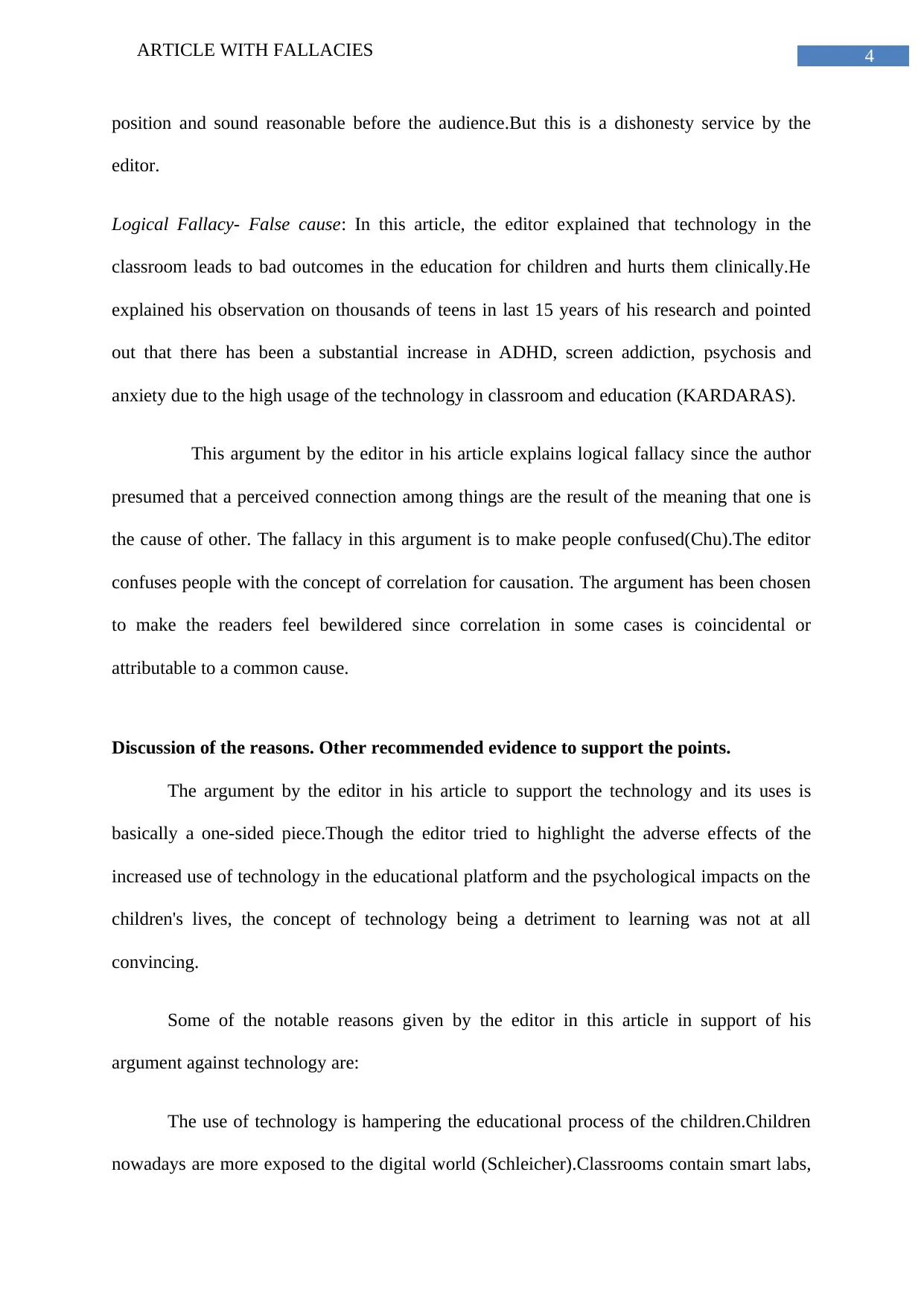
4ARTICLE WITH FALLACIES
position and sound reasonable before the audience.But this is a dishonesty service by the
editor.
Logical Fallacy- False cause: In this article, the editor explained that technology in the
classroom leads to bad outcomes in the education for children and hurts them clinically.He
explained his observation on thousands of teens in last 15 years of his research and pointed
out that there has been a substantial increase in ADHD, screen addiction, psychosis and
anxiety due to the high usage of the technology in classroom and education (KARDARAS).
This argument by the editor in his article explains logical fallacy since the author
presumed that a perceived connection among things are the result of the meaning that one is
the cause of other. The fallacy in this argument is to make people confused(Chu).The editor
confuses people with the concept of correlation for causation. The argument has been chosen
to make the readers feel bewildered since correlation in some cases is coincidental or
attributable to a common cause.
Discussion of the reasons. Other recommended evidence to support the points.
The argument by the editor in his article to support the technology and its uses is
basically a one-sided piece.Though the editor tried to highlight the adverse effects of the
increased use of technology in the educational platform and the psychological impacts on the
children's lives, the concept of technology being a detriment to learning was not at all
convincing.
Some of the notable reasons given by the editor in this article in support of his
argument against technology are:
The use of technology is hampering the educational process of the children.Children
nowadays are more exposed to the digital world (Schleicher).Classrooms contain smart labs,
position and sound reasonable before the audience.But this is a dishonesty service by the
editor.
Logical Fallacy- False cause: In this article, the editor explained that technology in the
classroom leads to bad outcomes in the education for children and hurts them clinically.He
explained his observation on thousands of teens in last 15 years of his research and pointed
out that there has been a substantial increase in ADHD, screen addiction, psychosis and
anxiety due to the high usage of the technology in classroom and education (KARDARAS).
This argument by the editor in his article explains logical fallacy since the author
presumed that a perceived connection among things are the result of the meaning that one is
the cause of other. The fallacy in this argument is to make people confused(Chu).The editor
confuses people with the concept of correlation for causation. The argument has been chosen
to make the readers feel bewildered since correlation in some cases is coincidental or
attributable to a common cause.
Discussion of the reasons. Other recommended evidence to support the points.
The argument by the editor in his article to support the technology and its uses is
basically a one-sided piece.Though the editor tried to highlight the adverse effects of the
increased use of technology in the educational platform and the psychological impacts on the
children's lives, the concept of technology being a detriment to learning was not at all
convincing.
Some of the notable reasons given by the editor in this article in support of his
argument against technology are:
The use of technology is hampering the educational process of the children.Children
nowadays are more exposed to the digital world (Schleicher).Classrooms contain smart labs,
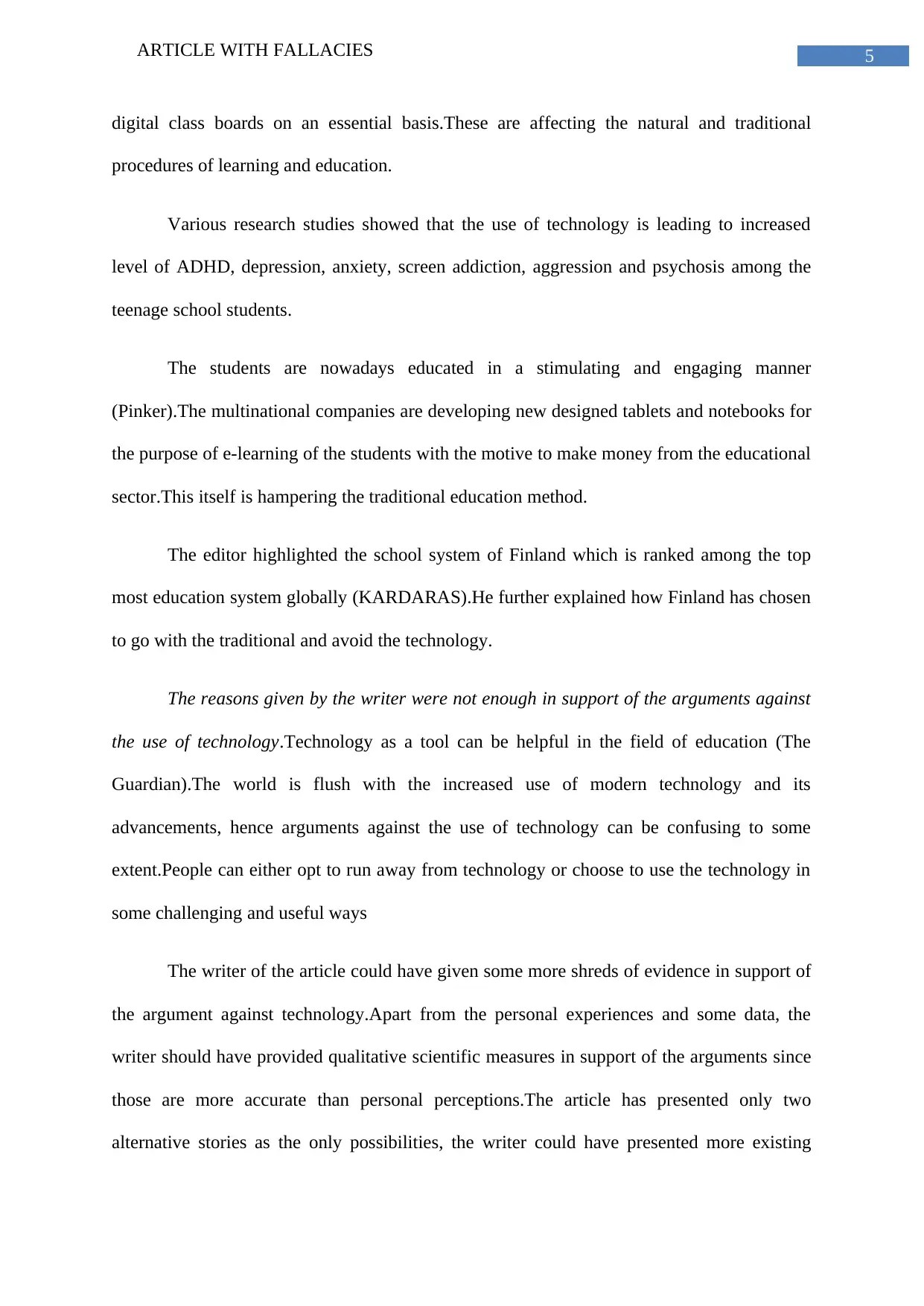
5ARTICLE WITH FALLACIES
digital class boards on an essential basis.These are affecting the natural and traditional
procedures of learning and education.
Various research studies showed that the use of technology is leading to increased
level of ADHD, depression, anxiety, screen addiction, aggression and psychosis among the
teenage school students.
The students are nowadays educated in a stimulating and engaging manner
(Pinker).The multinational companies are developing new designed tablets and notebooks for
the purpose of e-learning of the students with the motive to make money from the educational
sector.This itself is hampering the traditional education method.
The editor highlighted the school system of Finland which is ranked among the top
most education system globally (KARDARAS).He further explained how Finland has chosen
to go with the traditional and avoid the technology.
The reasons given by the writer were not enough in support of the arguments against
the use of technology.Technology as a tool can be helpful in the field of education (The
Guardian).The world is flush with the increased use of modern technology and its
advancements, hence arguments against the use of technology can be confusing to some
extent.People can either opt to run away from technology or choose to use the technology in
some challenging and useful ways
The writer of the article could have given some more shreds of evidence in support of
the argument against technology.Apart from the personal experiences and some data, the
writer should have provided qualitative scientific measures in support of the arguments since
those are more accurate than personal perceptions.The article has presented only two
alternative stories as the only possibilities, the writer could have presented more existing
digital class boards on an essential basis.These are affecting the natural and traditional
procedures of learning and education.
Various research studies showed that the use of technology is leading to increased
level of ADHD, depression, anxiety, screen addiction, aggression and psychosis among the
teenage school students.
The students are nowadays educated in a stimulating and engaging manner
(Pinker).The multinational companies are developing new designed tablets and notebooks for
the purpose of e-learning of the students with the motive to make money from the educational
sector.This itself is hampering the traditional education method.
The editor highlighted the school system of Finland which is ranked among the top
most education system globally (KARDARAS).He further explained how Finland has chosen
to go with the traditional and avoid the technology.
The reasons given by the writer were not enough in support of the arguments against
the use of technology.Technology as a tool can be helpful in the field of education (The
Guardian).The world is flush with the increased use of modern technology and its
advancements, hence arguments against the use of technology can be confusing to some
extent.People can either opt to run away from technology or choose to use the technology in
some challenging and useful ways
The writer of the article could have given some more shreds of evidence in support of
the argument against technology.Apart from the personal experiences and some data, the
writer should have provided qualitative scientific measures in support of the arguments since
those are more accurate than personal perceptions.The article has presented only two
alternative stories as the only possibilities, the writer could have presented more existing
⊘ This is a preview!⊘
Do you want full access?
Subscribe today to unlock all pages.

Trusted by 1+ million students worldwide

6ARTICLE WITH FALLACIES
possibilities in support of the logical argument.Lastly, the writer of the article attempted to
manipulate an emotional response in the place of a compelling argument in the article, this
act of the writer created a fallacy in the argument.
Reflection of personal experience.How it can help in past or future course.
Technology in a classroom is not a silver bullet.From my perception towards the
above article, adding technology in the daily lives of people cannot empower or lead to a life
full of success, but it can act as a catalyst to increase the advancement process of
learning.The writer in the article tried to focus on the connection between the over usage of
technology and mental health status of teenagers these days.The world today is growing at a
faster rate with the advancement in technological development (Pinker). Avoiding the
technology will thus result in keeping myself isolated from the advancement in the world
(Bulman, George and Robert).The idea or the database knowledge I gained from the above
arguments and logical fallacies will definitely help me in my future coursework and studies
since I will remember the effects of the overuse of technology.
possibilities in support of the logical argument.Lastly, the writer of the article attempted to
manipulate an emotional response in the place of a compelling argument in the article, this
act of the writer created a fallacy in the argument.
Reflection of personal experience.How it can help in past or future course.
Technology in a classroom is not a silver bullet.From my perception towards the
above article, adding technology in the daily lives of people cannot empower or lead to a life
full of success, but it can act as a catalyst to increase the advancement process of
learning.The writer in the article tried to focus on the connection between the over usage of
technology and mental health status of teenagers these days.The world today is growing at a
faster rate with the advancement in technological development (Pinker). Avoiding the
technology will thus result in keeping myself isolated from the advancement in the world
(Bulman, George and Robert).The idea or the database knowledge I gained from the above
arguments and logical fallacies will definitely help me in my future coursework and studies
since I will remember the effects of the overuse of technology.
Paraphrase This Document
Need a fresh take? Get an instant paraphrase of this document with our AI Paraphraser
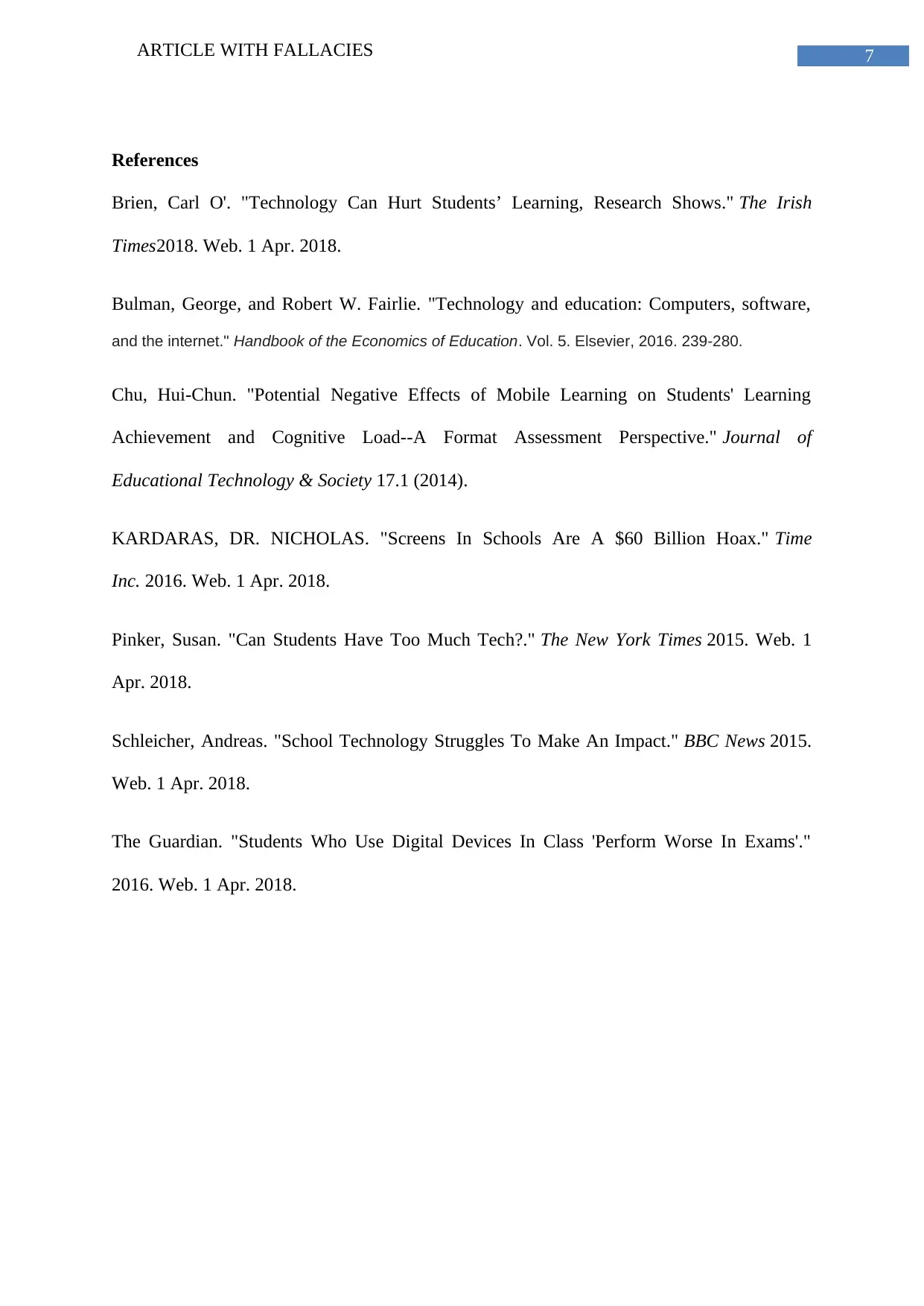
7ARTICLE WITH FALLACIES
References
Brien, Carl O'. "Technology Can Hurt Students’ Learning, Research Shows." The Irish
Times2018. Web. 1 Apr. 2018.
Bulman, George, and Robert W. Fairlie. "Technology and education: Computers, software,
and the internet." Handbook of the Economics of Education. Vol. 5. Elsevier, 2016. 239-280.
Chu, Hui-Chun. "Potential Negative Effects of Mobile Learning on Students' Learning
Achievement and Cognitive Load--A Format Assessment Perspective." Journal of
Educational Technology & Society 17.1 (2014).
KARDARAS, DR. NICHOLAS. "Screens In Schools Are A $60 Billion Hoax." Time
Inc. 2016. Web. 1 Apr. 2018.
Pinker, Susan. "Can Students Have Too Much Tech?." The New York Times 2015. Web. 1
Apr. 2018.
Schleicher, Andreas. "School Technology Struggles To Make An Impact." BBC News 2015.
Web. 1 Apr. 2018.
The Guardian. "Students Who Use Digital Devices In Class 'Perform Worse In Exams'."
2016. Web. 1 Apr. 2018.
References
Brien, Carl O'. "Technology Can Hurt Students’ Learning, Research Shows." The Irish
Times2018. Web. 1 Apr. 2018.
Bulman, George, and Robert W. Fairlie. "Technology and education: Computers, software,
and the internet." Handbook of the Economics of Education. Vol. 5. Elsevier, 2016. 239-280.
Chu, Hui-Chun. "Potential Negative Effects of Mobile Learning on Students' Learning
Achievement and Cognitive Load--A Format Assessment Perspective." Journal of
Educational Technology & Society 17.1 (2014).
KARDARAS, DR. NICHOLAS. "Screens In Schools Are A $60 Billion Hoax." Time
Inc. 2016. Web. 1 Apr. 2018.
Pinker, Susan. "Can Students Have Too Much Tech?." The New York Times 2015. Web. 1
Apr. 2018.
Schleicher, Andreas. "School Technology Struggles To Make An Impact." BBC News 2015.
Web. 1 Apr. 2018.
The Guardian. "Students Who Use Digital Devices In Class 'Perform Worse In Exams'."
2016. Web. 1 Apr. 2018.
1 out of 8
Your All-in-One AI-Powered Toolkit for Academic Success.
+13062052269
info@desklib.com
Available 24*7 on WhatsApp / Email
![[object Object]](/_next/static/media/star-bottom.7253800d.svg)
Unlock your academic potential
Copyright © 2020–2025 A2Z Services. All Rights Reserved. Developed and managed by ZUCOL.